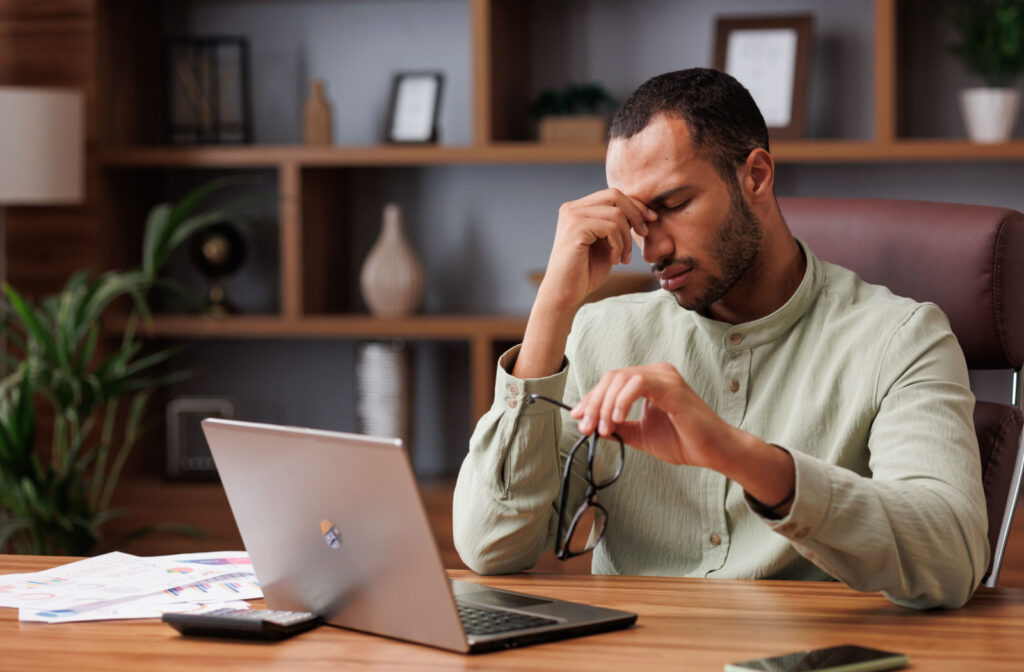In our digital world, we often find ourselves glued to screens from dawn to dusk. Whether it’s work, entertainment, or keeping in touch with friends and family, we rely on our eyes to process the information presented to us on these screens. With this increase in screen time, it’s not uncommon to experience digital eye strain. Fortunately, eye strain typically only lasts for about an hour after you stop whatever was causing your symptoms.
However, it’s important to note that you should visit your eye doctor for persistent cases of digital eye strain that continue long after you’ve stopped using a computer or device. There could be an underlying issue like an uncorrected refractive error causing your symptoms, which your optometrist can determine through a comprehensive eye exam.
What Is Digital Eye Strain?
Digital eye strain is a condition that results from prolonged periods of looking at digital screens such as computers, smartphones, and tablets.
Digital Eye Strain Symptoms
Some of the most common symptoms of digital eye strain are:
- Dry and irritated eyes
- Blurry vision
- Headaches
- Neck and shoulder pain
- Difficulty focusing
- Eye fatigue
- Eye redness
- Sensitivity to light
- Double vision
- Difficulty reading

Digital Eye Strain Treatment
Digital eye strain typically resolves itself within an hour or so after stopping whatever was causing it in the first place—working on your computer all day, for example.
It’s important to see your eye doctor if you’re experiencing persistent digital eye strain symptoms. They can examine your eyes to rule out underlying issues causing the symptoms, and they may have some suggestions for symptom relief. For example, if your eye strain is causing dry, irritated eyes, your eye doctor may recommend a high-quality lubricating eye drop.
Preventive Steps
Even though digital eye strain isn’t typically a vision-threatening condition, it can be uncomfortable to deal with while you wait for symptoms to subside. Although 100% prevention may not be possible, there are a few things to consider to lessen your risk of dealing with eye strain.
20-20-20 Rule
The 20-20-20 rule is a great way to both prevent digital eye strain and shorten the symptoms if you develop the condition. The rule is simple: for every 20 minutes of screen time, take a break and look at something 20 feet away for about 20 seconds. Next time you’re in the middle of a Netflix binge or an intense work session, remember the 20-20-20 rule.
Lighting
You can make things a whole lot easier on your eyes with the right lighting. Position your workspace so the windows are to the side of you, not behind or in front of your screen, to help prevent glare from the sunlight. You can adjust your office lighting so that it’s not too bright or dim. A little attention to your lighting can go a long way in keeping digital eye strain at bay.
Environment
You want your computer screen to be just below eye level. This helps keep your eyes from drying out too much, which can lead to those uncomfortable digital eye strain symptoms. You’ll also want to keep your screen about an arm’s length away. Too close and your eyes have to work overtime to focus, too far and you’ll be squinting to see.
Another environmental factor to consider is your chair position. Adjust it so your feet are flat on the floor, and your knees are at about the same height as your hips. This keeps your body aligned and comfortable, which can indirectly help prevent digital eye strain by reducing overall fatigue and discomfort.
What About Blue Light?
It’s very popular to talk about how blue light is closely connected to digital eye strain, and some believe that blue light-blocking glasses are the solution. But it turns out digital eye strain isn’t caused by blue light.
According to the American Academy of Ophthalmology, the symptoms of digital eye strain have more to do with how we use our digital devices, not the blue light they emit. This isn’t to say that blue light-blocking glasses—prescription or otherwise—don’t have their place and benefit. But digital eye strain prevention isn’t their primary purpose.
Discuss Your Symptoms with Your Eye Doctor
We’re living in a world that’s increasingly digital, and our eyes are working overtime to keep up. From the moment we wake up to the time we hit the hay, screens are a big part of our lives. And with all that screen time, it’s no surprise that digital eye strain has become a common issue.If you find that the symptoms don’t ease up even after you’ve stepped away from your screens, it’s a good idea to visit your eye doctor. Reach out to us at Annik Eye Care today, and book an appointment to discuss your eye strain symptoms with one of our experienced optometrists.



